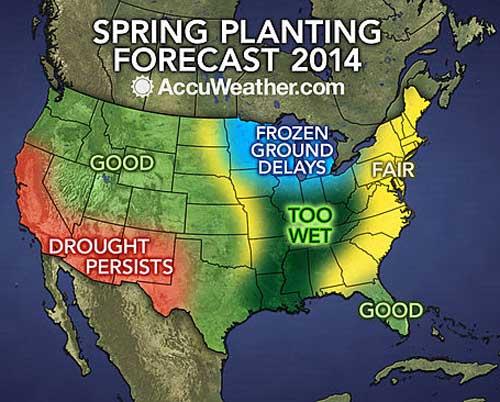
While the South will be right on schedule weather-wise for prime planting with looming frost concerns, delays will become more and more likely with every mile heading north.
Frozen Ground, Soil to Create Delays
Coming off a frigid, snow-filled winter for areas from the Great Lakes to the Ohio Valley and Northeast, spring will shape up to be mostly cool and wet.
"Damp soil leftover from winter, melting snow and lagging temperatures mean a lot of places are going to have a slow planting period across the Midwest, northern Plains and the Great Lakes," AccuWeather Senior Meteorologist Dale Mohler said.
With corn and soybeans being the largest crops in the Midwest and Plains, which are planted typically in April and May, one of the most influential factors in when to plant is soil temperature.
"Soil temperatures must be warm enough to support whatever crop you are planting," Mohler said. "For corn that's 50 F or above and for soybeans it's 54 F or above."
After this year's harsh winter with record-breaking cold and snow, meteorologists are concerned that because the ground is still frozen in the Ohio Valley and Upper Midwest, it will take longer for the frost to thaw out of the ground and as a result, keep soil temperatures lower longer.
In these areas, the ground is not expected to heat up quickly, as wetness in the early spring and summer is expected across the regions.
Melting Snow, Severe Weather May Generate Floods
With 92.19 percent of the Great Lakes covered in ice as of March 6, 2014, the water temperatures in the Great Lakes will need time to recover from the historic ice coverage.
"The influence will be in the areas on the east and south sides of the Lakes," AccuWeather.com Lead Long-Range Forecaster Paul Pastelok said. "Temperatures may not be quite as warm in the next couple of months going forward."
Along with the ice melt, snow melt along the Great Lakes and in the Upper Midwest can keep soil too moist and cool for planting even if normal temperatures are recorded in the region.
"The soil can't be too moist," Mohler said. "If it is the seeds might rot and it's difficult for machinery to be in the field; it can get stuck."
As a cool and wet start is in the forecast for the Northeast, any above-normal precipitation combined with frost and snow melt may produce some flash flooding events.
Unlike 2013, this year's biggest threats of heavy rain and flooding have shifted into the Midwest and the Mississippi Valley with wet periods in the forecast for both regions.
While the impacts of this year's winter will linger, severe weather season is now upon us which could potentially give farmers another hurdle to jump over.
With high pressure expected off the coast of New England in May, southeastern and eastern Florida could experience an increase in rainfall.
Any type of early tropical wave development could lead to some flooding, according to Pastelok.
Mounting Drought Concerns
With the wet season ending, this spring will be the second in a row with a severe drought for the areas from western Texas through central California, the extreme dryness will take a toll on the planting season.
"In late April to May, temperatures between 90F and 100F will be seen in the Sacramento Valley," Pastelok said.
Due to the severity of the drought, especially in California, water restrictions may be placed on farmers. To date there are no mandatory water restrictions on farmers.
As April is an essential month for wine growers with their grape vines awakening from their dormant stage, growers have immense water needs during this time period. With water restrictions in place, many could experience a significantly reduced crop this season due to the lack of available water resources alongside of the parched ground.
"The soil moisture will not be very deep so it will get used up fast," Mohler said. "They (growers) are going to have problems into the summer because there is too little moisture to last through the hot summer months."
Aside from the impacts on the wine industry, other crops such as vegetables and oranges will likely feel the effects of the drought as well in regards to their taste and relative size.
As the leading state for the production of almonds, artichokes, grapes, kiwi, olives, peaches, pomegranates, rice and walnuts, the result of the drought in California may also impact every state across the U.S., as prices for produce rise.
Weather Pattern May Favor Late Frost
While nothing out of the ordinary is predicted for the Northeast with typical cold shots and freezes in store for the region, the recent weather pattern does have meteorologists worried about late frosts in the lower Ohio and northern Tennessee valleys.
"It seems like the weather pattern has been one that favors some cold air masses coming into the central U.S.," Mohler said.
Two weeks beyond the normal freeze time, late April is the time period for the biggest frost concerns. As a result, timing the planting of corn and soybeans will be essential for the survival of the crops and the success of the harvest.
Source: accuweather.com



"With the wet season ending, this spring will be the second in a row with a severe drought for the areas from western Texas through central California, the extreme dryness will take a toll on the planting season. "
They have been drooling over drought for a lot more than 2 years. A can of Instant Cream of Famine Soup has been opened and dumped out in the Friendly Skies. They have achieved their goal. Nature has performed an end-run around their best efforts the previous 4 years in the West. Between the Midwest and California, a lot of food is produced. So, if they can't get their Carbon Taxes enacted, they'll surely get their arm & leg's worth by wrecking the food supply.